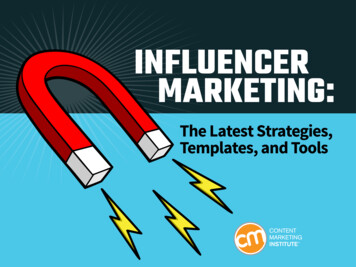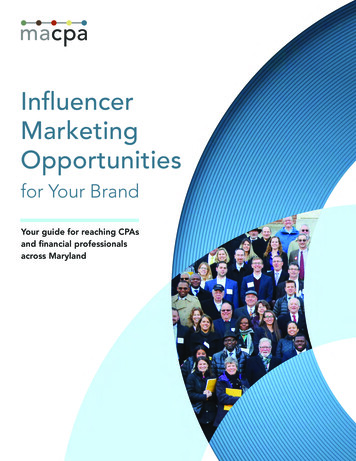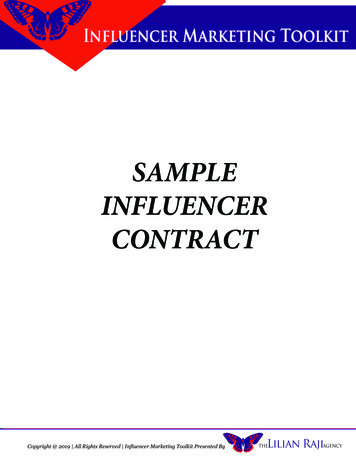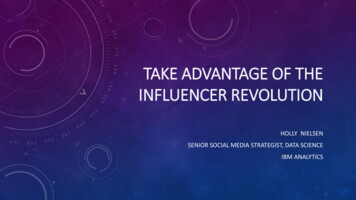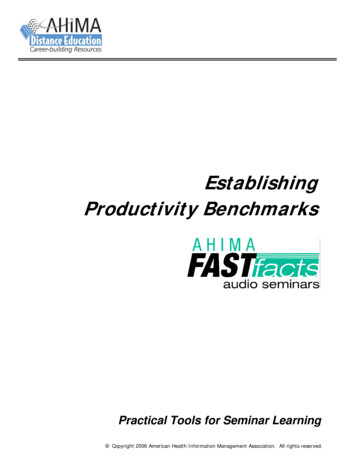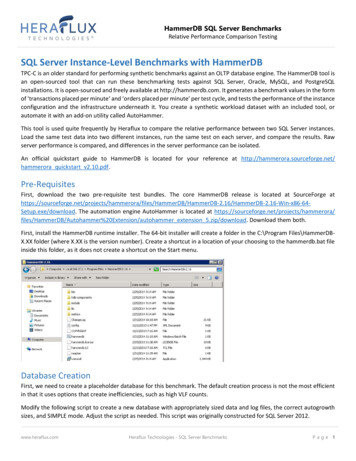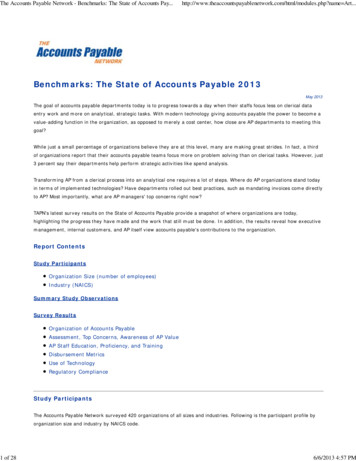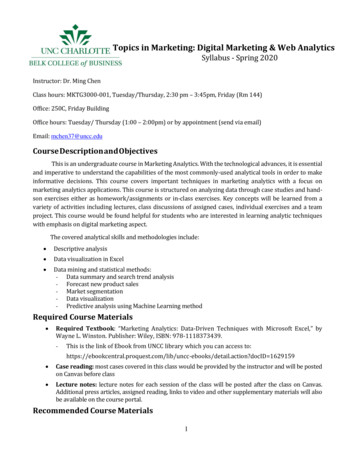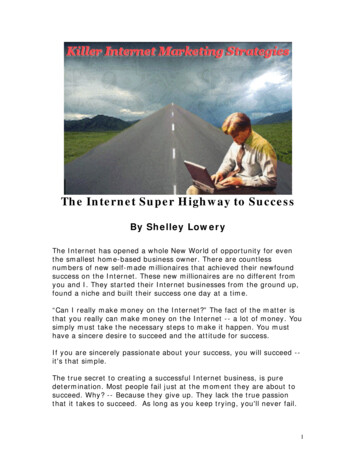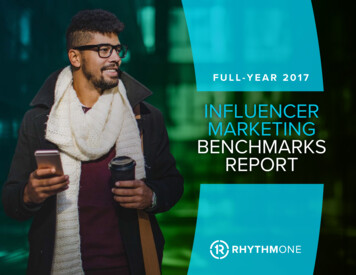
Transcription
FULL-YEAR 2017INFLUENCERMARKETINGBENCHMARKSREPORT
Table of ContentsAbout This Report . 3Full-Year 2017 Highlights 4Full-Year 2017 Influencer Marketing Campaigns Overview .6Campaign Tactics Social Amplification Paid Amplification — Influencer Social Ads Social Posts Social Media Listening Paid Amplification — Influencer Social Ads Emerging: Sharing Analytics and Smart LinksExecutive Summary 11 Earned Media Value– Earned Media Value Defined Engagement Rate Cost-Per-Engagement Social Media Listening Drive Amplification withProgrammatic Placements ConclusionsCategory-Specific Benchmarks .22Alcohol & Spirits Automotive Baby Care CPG Beverage CPG Food CPG Non-Food Education Electronics Entertainment Financial Products Grocery & Supermarkets Healthcare Home & Garden Pet Care Political Retail Software & Services Telecommunications Travel & TourismCase Studies .42Delta Faucets Travel AustinFull-Year 2017 Influencer Marketing Benchmarks ReportTABLE OF CONTENTS2
About This ReportThis Influencer Marketing Benchmarks Report for Full-Year 2017 offers an indepth analysis of 74 US-based campaigns that ran and were completed withRhythmInfluence between January and December 2017. During this period, 66unique brands spanning 19 advertiser categories ran campaigns withRhythmInfluence. More than 1,550 influencers created more than 8,700 pieces74Influencer MarketingCampaigns66Unique Brands19Advertiser Categories8,700 Pieces of BrandedContentof content, in aggregate, across the 74 campaigns.This report — the fifth in our series of Influencer Marketing benchmarking — is intended to provideadvertisers category-level data and key insights relative to branded content execution, consumerengagement, brand sentiment and lift, earned media value (i.e., ROI), and more.RhythmInfluence by RhythmOneRhythmInfluence is the only end-to-end data-driven influencer marketing solution built tomaximize the reach and impact of influencer content programs.Our access to a broad and deep pool of influencers allows us to connect with engagedcommunities at scale. Our proprietary analytics tools — Sharing Analytics and Smart Links —capture actionable data that demonstrates what content drives user engagement and whatencourages users to share with their family and friends. What’s more, our social distributionexpertise and industry-leading programmatic marketplace, RhythmMax, allow us to leverage thisdata and insights in social and programmatic environments to effectively advance prospects fromawareness to action.To learn more about RhythmInfluence, contact your RhythmOne account representative or visitRhythmOne.com Advertisers Influencer Marketing.Full-Year 2017 Influencer Marketing Benchmarks ReportTABLE OF CONTENTS3
Full-Year 2017HighlightsFor the majority of digital marketers, InfluencerMarketing has evolved from an emerging marketingpractice to a trusted strategy for consumer engagement.An estimated 86% of marketers used Influencer Marketingin 20171 — and an estimated 67% think it helps them reacha more targeted audience2.RhythmOne’s Influencer Marketing solutions leveragesocial media and programmatic channels that not onlyengage consumers at the micro-level, but scale tomaximize reach and impact. This report charts benchmarksfor our solutions and details how Influencer Marketing hashelped 66 unique brands in 19 advertising categoriesengage their consumers with branded content programs.1Sweeney, Erica. “Study: 39% of marketers will increase influencer marketing budgets in 2018.” Marketing Dive. December 4, 2017.Giordano. “Influencer Marketing in 2018: Becoming an Efficient Marketplace.” Adweek. January 15, 2018.2 Contestabile,Full-YearFull-Year 20172017 InfluencerInfluencer MarketingMarketing BenchmarksBenchmarksReportReportTABLE OF CONTENTS4
Full-Year 2017 HighlightsBenchmarks Snapshot Across the 74 unique campaigns we ran in 2017, theaverage spend on Influencer Marketingwas 70,685 per campaign — an increase of 38.6%over our full-year 2016 average of 51,000Advertisers that implemented an InfluencerMarketing campaign in 2017 receivedall campaigns in 2017 — proved to besignificant drivers of engagement.on average, which is a 4.4% increase over ourfull-year 2016 EMV average of 11.69.Engagement rate (ER) across allInfluencer Marketing campaigns was 8.20%,on average — an increase of more than 4xover our 2016 ER average of 2.01%.Marketing campaigns, down significantlyfrom 2016’s CPE average of 0.93.weeks saw, on average, an increase of 14.78%in brand mentions and an 8.73% increase inpositive brand sentiment (vs. mentions andsentiment prior to the campaign flight).Instagram Stories andSnapchat — utilized by 19.2% of 12.21 in earned media value(EMV) for every 1.00 of campaign spend,Average cost-per-engagement(CPE) was 0.24 across all InfluencerAdvertisers that ran an InfluencerMarketing program for two or moreCPEFull Year 2017 Influencer Marketing Benchmarks ReportA Retail advertiser that applied our emergingSharing Analytics and Smart Linksofferings to its Influencer Marketing campaign saw aReturn on Advertising Spend (ROAS) of 26 and aprogrammatic placement conversion rate of 1.19%.Advertisers in select categories that havecommoditized products generally found successwith engagement when influencers showcasedthe products and branded content in highlycreative, DIY-style applications.TABLE OF CONTENTS5
Full-Year 2017Influencer MarketingCampaigns OverviewSimilar to 2016, in 2017 the CPG Food advertiser category tops our listin both total count (28.4% of all campaigns, vs. 35.1% last year) and totalspend (23.8% of all campaigns, vs. 42.6% last year). Of note: Retail gainedground this year, compared to last (12.2% of count and 7.9% of spend in2017, vs. 2.6% of count and 5.9% of spend in 2017).Full-YearFull-Year 20172017 InfluencerInfluencer MarketingMarketing BenchmarksBenchmarksReportReportTABLE OF CONTENTS6
Full-Year 2017 Influencer MarketingCampaigns OverviewFull-Year 2017 Influencer Marketing CampaignsThe average spend on Influencer Marketing campaigns in2017 was 70,685 per campaign. Among the 66 unique brands,22.7% had a total program spend of 100K or more (vs. 12% in2016), 22.7% spent between 50K- 99.9K (vs. 21% in 2016),34.8% spent between 25K- 49.9K, and 19.7% spent 24.9K orless. For comparison, two out of every three (67%) InfluencerMarketing campaigns in 2016 were 49,999 or less.by Advertiser Category23.8%CPG Food7.9%Retail9.5%6.4%8.1%8.2%6.8%5.1%5.4%Travel & TourismCPG BeverageEducationHome & Garden4.1%3.6%4.1%Financial ProductsHealthcareGrocery & et CareEntertainmentElectronicsBaby CareAlcohol & Spirits12.2%4.1%Software & ServicesCPG Non-Food28.4%% SpendBY COUNT13.6%CPG Food was followed by: Retail (12.2%) Software & Services 0.9%1.4%0.4%1.4%0.9%1.4%0.3%1.4%3.2%1.4%% Count, Travel & Tourism (8.1%) CPG Beverage (6.8%)BY SPEND15.8%Full-Year 2017 Influencer Marketing Benchmarks ReportCPG Food was followed by: Political (15.8%)1 Home & Garden (13.6%) CPG Beverage (8.2%) Retail (7.9%)By advertiser category, total campaign spend averages wereas follows:PoliticalHome & GardenAlcohol & SpiritsCPG BeverageTelecommunicationsEducationFinancial ProductsCPG FoodTravel & TourismRetailElectronicsPet CareAutomotiveSoftware & ServicesGrocery & SupermarketsHealthcareEntertainmentCPG Non-FoodBaby Care 824K 236.7K 165K 85.7K 75K 66.3K 62.7K 59.4K 55.8K 45.8K 45K 45K 37.5K 30.9K 27.5K 27.5K 23K 17.5K 15K1 RhythmOneacted as the Influencer Marketing and social agency for aninternational political organization as part of a local 2017 election. In thisactivation, we utilized a number of tactics — including Facebook ads, paidsearch, Google Display Network, YouTube Ads, and Influencer content — tohelp share the organization’s messaging. Due to the unique nature of thisactivation, certain campaign metrics were not included in campaign reportingas they did not exist in the grassroots efforts implemented by RhythmOne.TABLE OF CONTENTS7
Full-Year 2017 Influencer Marketing Campaigns OverviewCampaign TacticsFor brands, there is no more effective place to engage consumersthan a trusted environment. RhythmOne helps marketers connect withpassionate influencers that authentically weave branded stories intocontent and social platforms that consumers trust, delivering powerfulresults. Whether it’s a story told through a blog post, video, a picture,or any combination of these, we work with influencers to ensure theybring brands and products to life with engaging, custom contentdelivered to the right audience — amplified through the channels thatwill make the greatest impact.SPONSORED BLOG POSTSSOCIAL AMPLIFICATIONEvery campaign that ran a Sponsored Blog Post component also ranSocial Amplifications.The Social Amplification of Sponsored Blog Posts occurs wheninfluencers promote the blog post(s) across their social media accountsincluding Instagram, Pinterest, Facebook, Twitter, and LinkedIn.Influencers use the features of the specific platforms to creativelyfeature images, video, campaign hashtags, etc. that tie back to theoriginal Sponsored Blog Post.The majority (77%) of our 2017 Influencer Marketing campaignsincluded a Sponsored Blog Post.Sponsored Blog Posts pair advertisers with influencers who developand distribute long-form content — approved by the brand — thatpromotes products, services, or other initiatives. Depending on thespecifics of the program, the content of Sponsored Blog Posts take theform of text, imagery, and/or video.“We [are] fortunate to work with influencers whoare passionate about the assets we create. They’reable to share our organic content with theirmassive audiences and drive earned exposure.” 1— Tad Ehrbar, SVP, Global ConsumerSocial Media and Content, Citi1 Minsker,Maria. “Social Feeds Are Cluttered, but Citi Says There's Still Room for Brands.” eMarketer.November 7, 2017.Full-Year 2017 Influencer Marketing Benchmarks ReportTABLE OF CONTENTS8
Full-Year 2017 Influencer Marketing Campaigns OverviewCampaign Tactics (continued)SOCIAL POSTSTwo-thirds (66%) of our 2017 Influencer Marketing campaigns featured Social Posts.Our Social Posts component activates influencers to create original content to liveexclusively on their own social media channels, including Instagram, Snapchat,Pinterest, Facebook, LinkedIn, and Twitter. Posting content in this capacity allows forour influencers to create and share succinct messaging that can include images,videos, campaign hashtags, and brand social handle tagging. Social Posts typicallygarner strong engagement, especially when targeting audiences of millennials.“Historically influencers have been celebrities, but today,thanks to millennials, it’s not always about celebrities.Rather, it’s about relatability. Influencers can simply bepeople who have similar lifestyles.”1— Mindy MurrayBrand Communications Manager, 3MPAID AMPLIFICATION — INFLUENCER SOCIAL ADSMore than four-in-five (82%) of our 2017 Influencer Marketing campaigns featuredInfluencer Social Ads.Influencer Social Ads are the paid promotion of influencer content across Facebookand/or Instagram. The promoted posts are pushed through the influencers’ socialprofiles directly, vs. the social media accounts of brands. This allows advertisers toalign their branded content with very specific audiences by leveraging RhythmOne’sanalytics and the respective platform’s targeting capabilities. We then optimize acrossvarious influencers, content, and platforms to drive success.1 Minsker,Maria. “Cuteness Sells: The New Twist Scotch-Brite Puts on Influencer Marketing.” eMarketer. May 19, 2017.Full-Year 2017 Influencer Marketing Benchmarks ReportTABLE OF CONTENTS9
Full-Year 2017 Influencer Marketing Campaigns OverviewCampaign Tactics (continued)SOCIAL MEDIA LISTENINGIn 2017, we produced Social Media Listening reports for keyadvertising partners. Specifically, we tracked fluctuations in campaignpositive sentiment, brand mention lift, and brand sentiment lift. SocialMedia Listening is offered to our clients on a campaign-by-campaignbasis for programs that run for at least two weeks.EMERGING: SHARING ANALYTICS ANDSMART LINKSIn 2017, one Influencer Marketing campaign in the Home & Gardencategory ran with two new-to-market products that are specificallyFull-Year 2017 Influencer Marketing Benchmarks Reportgeared towards tracking social sharing: Sharing Analytics and SmartLinks. With Sharing Analytics, we analyze the activity of users that shareand engage with content through copy and paste activity — and thentrack sharing on traditional social platforms as well as on dark socialchannels including email, IMs, and text.With Smart Links, advertisers can control the paths of consumers ontheir sites based on country, state-level geo, and/or mobile device.Smart Links provide deep insights on consumers who click onshortened links from Influencer Marketing campaigns and allow forsegmentation to maximize programmatic targeting.TABLE OF CONTENTS10
Executive SummaryFull-Year 2017 Influencer Marketing Benchmarks ReportTABLE OF CONTENTS11
Executive SummaryEarned Media ValueAdvertisers that implemented an Influencer Marketing campaign in 2017received 12.21 in earned media value (EMV) for every 1.00 ofcampaign spend, on average. This is a 4.4% increase over our full-year2016 EMV average of 11.69. See the “Earned Media Value Defined”section of this report for more details into the criteria we use to calculateEMV and how campaign-specific factors affect what is calculated. 12.21FULL YEAR2017 EMVAVERAGEAverage Earned MediaValue for Every Dollarof Campaign SpendBy Advertiser Category*EntertainmentThe average EMV return breakdown is as follows: 36.31 36.31Retail
Paid Amplification — Influencer Social Ads Social Media Listening .
